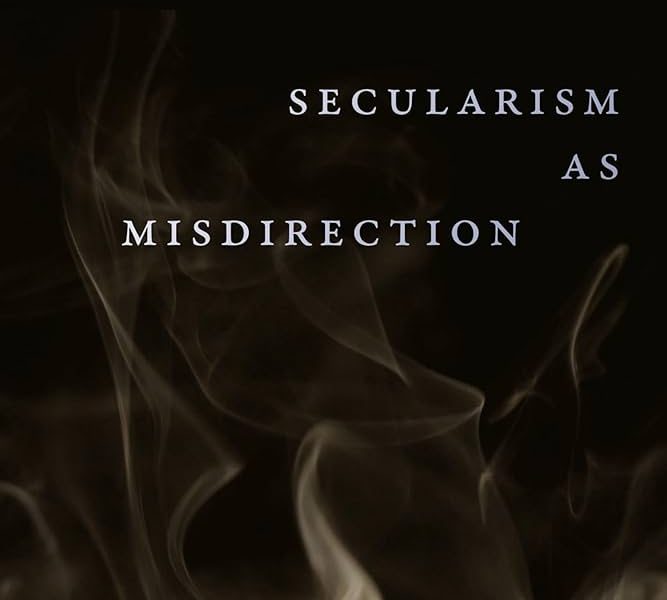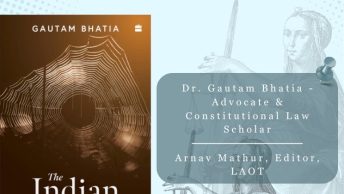Summary: In this piece, we continue the discussion on Prof. Nivedita Menon’s latest book, Secularism as Misdirection: Critical Thought from the Global South. The summary of the book by Prof. Menon can be accessed here. Its review by Prof. Kalpana Kannabiran can be accessed here, and by Prof. Aditya Nigam can be accessed here. In this piece, Prof. Hilal Ahmed provides his comments on the first and second chapters of the book.
This is an unconventional book in two ways. First, the book invites us to problematize the given story of secularism as a political concept by critically examining the concerns it overstates and the issues it completely ignores. The book examines the configuration of religion and women as secularism’s preferred domain. At the same time, it takes us to a few unexplored sites—global capitalism, caste, psychoanalysis, and ecological injustice—which do not feature in the usual debates on secularism. The term ‘misdirection’ is evoked to explain this strange conceptual-political trajectory. The book is not invested in the typical concerns—’reinvent or reject secularism.’ Instead, it proposes that ‘secularism is not a value in itself but only a strategy of governance (p.315).’ This radical departure from the conventional debates on secularism opens a few innovative intellectual possibilities.
There is another, and perhaps, more important aspect of this study that makes it exceptional. The author deconstructs the established explanatory frames—secularism, multiculturalism environmentalism—to highlight the limitations of these conceptual tools in addressing the contemporary economic and political challenges. This radical deconstruction reflects an honest adherence to academic rigorousness and established procedure of serious interdisciplinary research. Yet, the study cannot entirely be described as a purely academic endeavor. Menon offers us an intellectually creative, conceptually exciting, and politically embedded analytical framework. In a way, it is a serious attempt to reconstruct a new mode of collective political-academic thinking. The subtitle of the book, Critical Thought from the Global South, hence, makes a perfect sense.
Focusing on Chapter 1 and 2, I shall try to discuss the overall architecture of the book and the internal configuration of the main arguments. More specifically, I am interested in two basic issues: the significance of religion/secular binary and its multifaceted political manifestations and a new imagination of democracy as a value.
Religion/Secular
Highlighting the limits of religion/secular binary, Menon shows the complex making of contemporary Hindutva politics. She underlines three ways in which politics of Hindu Rashtra functions: a formal dispossession and disowning of Muslims, creating a controlled chaos for political manoeuvring and an unprecedented crackdown on dissent and control of media organisations. She argues that ideal of Hindu Rashtra has now become a state project. This line of argument is very useful to understand the location of secularism in the realm of Hindutva politics. The Hijab controversy, which is discussed in detail in Chapter 2, is very relevant here. Although the BJP leaders do not use the word secularism to justify their aggressive Hijab politics, they evoked an old secular argument that religion is a matter of personal choice and it should not have any space in public life. The concerned educational institutions and administrative authorities in the state also asserted that religious attires of any kind, especially Hijab, should not be permitted in schools to uphold the sanctity of secular education. In fact, the Karnataka High Court went a step further to claim that Hijab could not be treated an essential Islamic practice. This controversy shows that secularism can also be used as a tool to nurture anti-Muslim politics. Menon, however, does not want us to abandon secularism as an entirely unimportant category of analysis. For her, secularism is not in itself a positive value and nor is its meaning self-evident. She makes it clear that ‘secularism can serve majoritarian, anti-minority politics, and capitalist transformation, but it can equally be invoked to sustain democratic politics that respects heterogeneity, social justice, and ecological concerns’ (p.33).
This crucial observation is very relevant to understand the constitution of religion and its relationship with secularism. The argument that secularism itself is ‘neither authoritarian nor democratic but can be articulated in either discourse’ (p.53) offers us a useful vantage point to unpack the entity called ‘religion.’ It explains how the secular state defines religion by using certain legal devices—essential practices test, recognizing deities as juristic persons and the controlling of the finances of religious bodies. This statist interpretation establishes a powerful claim that religion can only be imagined as a homogeneous, standardized, and fixed legal entity. The self-perception of religious communities and their political orientations are deeply influenced by such legal-judicial interventions. The Supreme Court judgement in the famous Bal Thakre case is a good example in this regard. This judgement evokes secularism to criticize the misuse of religion for political-electoral purposes. However, at the same time, it recognizes Hindutva as a purely philosophical non-political doctrine—’a way of life’. This legal depoliticization of Hindutva played a crucial role in transforming the dominant narrative of nationalism in post-2014 India.
A critical question arises here: Is it possible to find certain aspects of religion, which are independent, autonomous, and have not yet been encroached upon by the secular state? Menon does not answer this question directly; instead, she introduces us to the field of psychoanalysis to explain the location of myths, beliefs, and fears in the everyday life of modern communities. Menon evokes the term paramodern, to argue that this domain ‘represents an uncolonized, unsubordinated “outside” that may get reconstituted in its encounter with the modern, but is certainly not to be understood as a product of or produced by the modern. The modern, in trying to expunge it, drives it underground, yet it does constitute a dominant experience of these societies.’ (p.242). I find this idea productive. It explains the complex relationship between a highly diversified spiritual universe, which is shared by various faith communities and the domain of standardized religions, where practices, institutions and scriptures are always defined in cultural, legal, and even civilizational terms.
Democracy as a value
One of the central arguments of the book is that we must recognize democracy, not secularism, as a positive value. For Menon, democracy is not merely about electoral system in the formal sense, it is ‘something more fundamental, to the ways in which people seek autonomy to shape their lives and worlds, whether as individuals or as communities.’ (p.316). She uses the term “postnational” to describe the non-hegemonic nature of these struggles. Elaborating the scope of this multifaceted quest for democracy, Menon includes social justice (class, caste, race, gender, and multiple other dimensions) and ecological justice (recognizing the human as merely one part of a vaster nature) as meaningful values, which capture the essence of contemporary struggles.
Democracy as a desired value, the book argues, must be understood in relation to three crucial developments. The dominance of state and supra-states corporations in the economic and political life is the first significant trajectory of the present century. Menon highlights the deeper social and cultural impact of this emerging (and ever-expanding) form of capitalism and state power. The rise of new kind of struggles against the state and neo-capitalism is the second recognizable feature of the contemporary moment. These struggles have not merely posed a serious challenge to the older forms of political organizations but have also produced a completely new and unrecognizable languages of politics. The third recent trajectory, is something, which has not yet been given adequate attention so far. Menon describes it as the ‘powerful pull by different groups of people and individuals away from states—from their largesse and their surveillance’ to create an ‘outside’ (p.383). She finds new possibilities of doing productive politics in this domain of the ‘outside’ because it enables the individuals and communities to escape the governmentality rather than becoming an object of it.
The book, more broadly, identifies two possible means to realize the multifaceted idea of democracy—insurgent constitutionalism and the escaping from the state and capitalism. Problematising the unease of the traditional Left politics of the 20th century towards liberal constitutionalism, Menon asserts that the constitution can also be invoked as source for doing different kind of politics. The radical impulse of the constitution, in this sense, could became ‘something of a manifesto of a future state of affairs in which an ethos of egalitarianism could be invoked.’ (p.332). The spirit of this insurgent constitutionalism is very clearly reflected in the recent agitations such anti-CAA sit in at Shaheen Bagh, farmers’ protest against the three farm laws passed by the Modi regime and the protest led by a few internationally-known wrestlers against the alleged sexual harassment of young female wrestlers by the BJP leader and the president of the Wrestling Federation of India, Brij Bhushan Sharan Singh. The protesters evoked the constitution not merely to assert their legal rights as citizens but also underline a moral claim.
Escaping from the state and the influence of capitalism is presented as another possibility. Drawing on J. K. Gibson-Graham’s argument that there are aspects of social life which are not captured by capitalism, Menon reiterates the importance of multiple non-capitalist practices, which exist alongside or outside of capitalism. She makes a distinction between work and labor to argue that the ‘goal would not be to escape work, then, but to escape (alienated) labour, to encourage and be in solidarity with all the ways in which people’s activities escape capitalism, or are invisible to it. The goal would be to be in solidarity with struggles of people to build and protect non-capitalist ways of life, collective rights to land and property of different sorts’ (p.360).
While appreciating the intellectual significance of Menon’s main argument, I would like to underline three critical points. First, secularism in the context of Indian politics has its own value. It is true that the term secularism became the dominant narrative of Indian public life after the demolition of the Babri Masjid in 1992. However, the story of secularism is slightly older. It has always been recognized as a legitimate legal, moral, and political safeguard to protect the existence of religious minorities, particularly Muslims. The postcolonial Muslim politics relies heavily on three unwritten norms—adherence to the legal-constitutionalism, emphasis on Muslim unity to assert collective strength as a minority, and an elusive idea of ‘Muslim contribution’ in the nation building process to proclaim equal and dignified citizenship (Ahmed, 2014). These norms of Muslim politics are based on an India-specific conception of secularism, which ensures the numerically inferior groups that their religious traditions and/or cultural distinctiveness are legally protected. Interestingly, the Pasmanda Muslim politics, which posed a serious challenge to the dominance of elite-Ashrafs, does not give up the idea of secularism either. The Pasmanda demand that Scheduled Caste category must include Muslim Dalits and Christian Dalits is based on the claim that the affirmative action policies should completely be secularized (Ahmed, Alam, Parveen 2025). Secularism, thus, cannot merely be described as a misdirection. This criticism, I must admit, does not destabilize the architecture of Menon’s argument. She does not rule out the possibility that secularism can also be used for doing politics of minority rights. However, the book does not pay sufficient attention to this positive story of secularism in India, which creates a (mis)impression that secularism is nothing but a deviation from something that is real.
This brings us to the idea of the ‘outside’ and the question of new solidarities. No doubt, it is a fascinating point of departure to explore new forms of collective assertions against capitalist dominance and state’s surveillance. The celebrated ideal of the previous century that a party-led revolution is needed to achieve social and economic transformation has already become irrelevant. Menon’s argument that contemporary people-led agitations and protests are not interested in the formal party-like organizations is noteworthy. Similarly, her claim that the ‘escaping strategies’ of groups and individual from the webs of capitalism and state must be recognized as a radical response, also makes sense in the present scenario. It, however, raises, a different set of questions: are these newer forms of radical politics capable in challenging the hegemony of the highly organized, interested-oriented, technology-driven, and state-protected global capitalism? What are the possibilities to ‘move out’ from the ever-expanding net of capitalism, especially when the alternative vision of ecological justice (such as Green Energy) is also appropriated by the global economic elites? Is it possible to avoid the presence of the state, which is deeply invested in the idea of surveillance?
A recent example is relevant here to substantiate these concerns. The three farm laws and the contentious issue of minimum support price were the key factors that forced the farmers of Punjab, Haryana and western Uttar Pradesh to organise themselves as a collectivity. They came together to resolve these specific issues. Despite the hostile attitude of the government, this protest was successful in achieving its immediate objectives. However, the plight of the farmers could not become a nationwide public concern. The wrestlers’ protest had a very similar trajectory. It was led by celebrated sportspersons, including the Olympic medallists, Vinesh Phogat and Bajrang Punia. The protesters raised the issue of sexual harassment and demanded that action must be taken against Brij Bhushan Sharan Singh. The government almost ignored these demands and did not take swift action. This ambivalent attitude was counterproductive as the protest intensified. Despite various ups and downs, the wrestlers’ agitation could not fully achieve its basic objectives. Like the farmers’ protest, this struggle also could not sensitise public opinion in a significant way. It is important to note here that the farmers’ outfit, the Samyukt Kisan Morcha, strongly supported the wrestlers’ agitation. In fact, the SKM called for a nationwide demonstration in support of the wrestlers. Despite this close and proximate relationship, these two very powerful socio-political agitations could not become a collective force or a mass movement of some kind. In this context, it was natural for the individual leaders associated with these protests to move towards the Opposition parties, especially the Congress. This example underlines the fact that issue-based protests are either managed by the state easily or they are appropriated by the political parties to reproduce the systemic equilibrium in the long run.
Finally, a technical point. The book makes a courageous attempt to reflect upon a range of issues, while maintaining academic rigorousness and intellectual integrity. The vastness of this book gives it a unique character and forces the reader to envisage the big picture in its multiplicity. The academic rigorousness, on the other hand, introduces us to a variety of literature, which Menon uses to weave a highly persuasive narrative. Still, as a reader, I encounter an inexplicable tussle between a serious scholar and a deeply committed political individual. Menon, the scholar follows the conventions of research and remains honest to her ‘materials’; while Menon as a politically sensitive individual tries her best to get rid of the limits set out by the academic research. This tension is used very creatively to open up the scope of the identified questions for a highly productive discussion. Yet, one finds an over reliability on academic ‘materials’, which many a time actually becomes a hurdle. Menon, it seems is aware of this problem. That is why she asserts: ‘…we can but hope for moments of Utopia—those moments that dismantle settled knowledge and set up unprecedented conversations; conversations which permit the outside to enter and transform them, and which enter the outside to transform it’ (p.388).
References:
Author Bio: Prof. Hilal Ahmed is an Associate Professor at the Centre for the Study of Developing Societies (CSDS), New Delhi. He works on political Islam, Indian democracy, and the politics of symbols in South Asia.







Фир & Tof – Домой скачать песню и слушать онлайн
https://allmp3.pro/3269-fir-tof-domoj.html
Grishina и «Storm DJs» – До кипения скачать песню и слушать онлайн
https://allmp3.pro/2836-grishina-i-storm-djs-do-kipenija.html
Catrine – Водоворотами скачать песню и слушать онлайн
https://allmp3.pro/2825-catrine-vodovorotami.html
YADDAY & Azzi – Дождик скачать песню и слушать онлайн
https://allmp3.pro/2458-yadday-azzi-dozhdik.html
Таисия Повалий – Особенные слова скачать песню и слушать онлайн
https://allmp3.pro/2624-taisija-povalij-osobennye-slova.html
Отпетые мошеники & M83 – Люби меня люби (Vlas Of Beats Remix) скачать песню и слушать онлайн
https://allmp3.pro/2991-otpetye-mosheniki-m83-ljubi-menja-ljubi-vlas-of-beats-remix.html
VERBEE – Один скачать песню и слушать онлайн
https://allmp3.pro/2715-verbee-odin.html
Bittuev – Хулиган скачать песню и слушать онлайн
https://allmp3.pro/2757-bittuev-huligan.html
Андрей Язвинский & Наталья Язвинская – Ветерок скачать песню и слушать онлайн
https://allmp3.pro/2915-andrej-jazvinskij-natalja-jazvinskaja-veterok.html